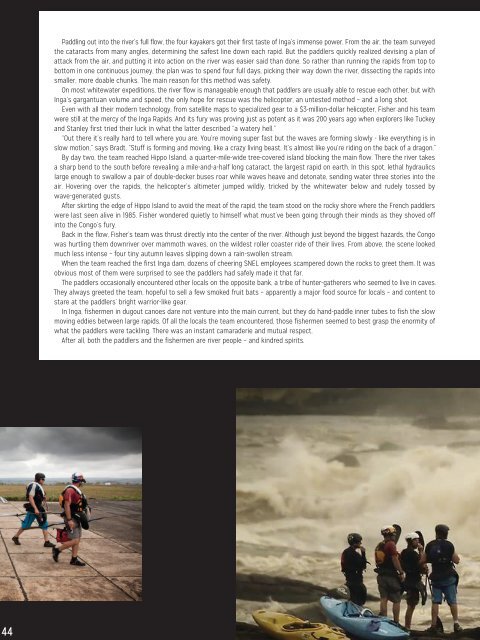River Karma
Typography project: Curated a typographic system that can be applied to various issues and structural spreads successfully where content influences the overall style and reading experience. Self created concept that focuses on grid and typographic hierarchy development pulling all articles and photographic sources from existing publications.
Typography project: Curated a typographic system that can be applied to various issues and structural spreads successfully where content influences the overall style and reading experience. Self created concept that focuses on grid and typographic hierarchy development pulling all articles and photographic sources from existing publications.
Create successful ePaper yourself
Turn your PDF publications into a flip-book with our unique Google optimized e-Paper software.
44<br />
Paddling out into the river’s full flow, the four kayakers got their first taste of Inga’s immense power. From the air, the team surveyed<br />
the cataracts from many angles, determining the safest line down each rapid. But the paddlers quickly realized devising a plan of<br />
attack from the air, and putting it into action on the river was easier said than done. So rather than running the rapids from top to<br />
bottom in one continuous journey, the plan was to spend four full days, picking their way down the river, dissecting the rapids into<br />
smaller, more doable chunks. The main reason for this method was safety.<br />
On most whitewater expeditions, the river flow is manageable enough that paddlers are usually able to rescue each other, but with<br />
Inga’s gargantuan volume and speed, the only hope for rescue was the helicopter, an untested method – and a long shot.<br />
Even with all their modern technology, from satellite maps to specialized gear to a $3-million-dollar helicopter, Fisher and his team<br />
were still at the mercy of the Inga Rapids. And its fury was proving just as potent as it was 200 years ago when explorers like Tuckey<br />
and Stanley first tried their luck in what the latter described “a watery hell.”<br />
“Out there it’s really hard to tell where you are. You’re moving super fast but the waves are forming slowly - like everything is in<br />
slow motion,” says Bradt. “Stuff is forming and moving, like a crazy living beast. It’s almost like you’re riding on the back of a dragon.”<br />
By day two, the team reached Hippo Island, a quarter-mile-wide tree-covered island blocking the main flow. There the river takes<br />
a sharp bend to the south before revealing a mile-and-a-half long cataract, the largest rapid on earth. In this spot, lethal hydraulics<br />
large enough to swallow a pair of double-decker buses roar while waves heave and detonate, sending water three stories into the<br />
air. Hovering over the rapids, the helicopter’s altimeter jumped wildly, tricked by the whitewater below and rudely tossed by<br />
wave-generated gusts.<br />
After skirting the edge of Hippo Island to avoid the meat of the rapid, the team stood on the rocky shore where the French paddlers<br />
were last seen alive in 1985. Fisher wondered quietly to himself what must’ve been going through their minds as they shoved off<br />
into the Congo’s fury.<br />
Back in the flow, Fisher’s team was thrust directly into the center of the river. Although just beyond the biggest hazards, the Congo<br />
was hurtling them downriver over mammoth waves, on the wildest roller coaster ride of their lives. From above, the scene looked<br />
much less intense – four tiny autumn leaves slipping down a rain-swollen stream.<br />
When the team reached the first Inga dam, dozens of cheering SNEL employees scampered down the rocks to greet them. It was<br />
obvious most of them were surprised to see the paddlers had safely made it that far.<br />
The paddlers occasionally encountered other locals on the opposite bank, a tribe of hunter-gatherers who seemed to live in caves.<br />
They always greeted the team, hopeful to sell a few smoked fruit bats – apparently a major food source for locals – and content to<br />
stare at the paddlers’ bright warrior-like gear.<br />
In Inga, fishermen in dugout canoes dare not venture into the main current, but they do hand-paddle inner tubes to fish the slow<br />
moving eddies between large rapids. Of all the locals the team encountered, those fishermen seemed to best grasp the enormity of<br />
what the paddlers were tackling. There was an instant camaraderie and mutual respect.<br />
After all, both the paddlers and the fishermen are river people – and kindred spirits.


